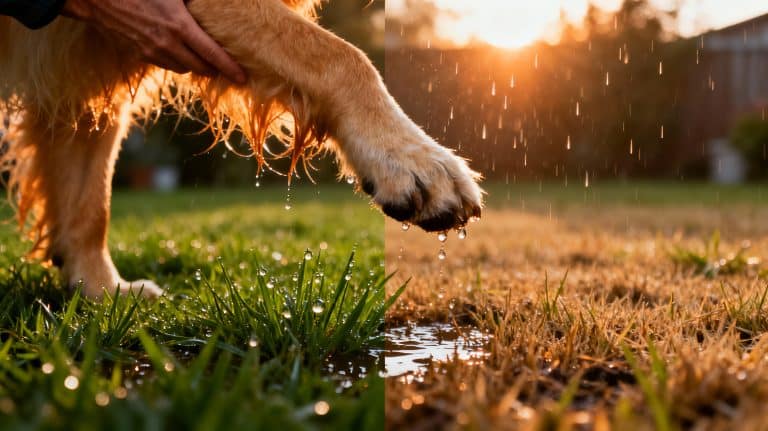Short answer: it’s risky while it’s wet, and still something to treat with caution after it dries.
It’s natural to feel concerned. Your immediate move is simple: keep your dog off the treated area and close the bottle. If your dog has already walked through it, bring them inside and rinse their paws with mild soap and lukewarm water for a few minutes.
You might still smell that sharp, slightly sweet chemical note on the patio while your dog paws at the back door. Let’s make a clear plan.
Roundup and Dogs: Quick Answer and First Steps
-
If you just sprayed: Keep pets off until the area is completely dry. On a warm, breezy day, that’s often 2-4 hours. In cool, shady, or humid conditions, plan for longer, ideally 24 hours.
-
If your dog touched it wet: Wash paws, belly, and any coat that could brush plants. Use dish soap and lukewarm water for 5-10 minutes. Offer fresh water and monitor for drooling, lip smacking, vomiting, or diarrhea.
Not sure which Roundup you used? Check the front label. “Roundup Weed & Grass Killer” is glyphosate-based. “Roundup for Lawns” is a different formula (often with 2,4-D, MCPP/MCPA, dicamba). Directions and risks differ.
Roundup Pet Safety: Why Advice Conflicts
Two things trip people up. First, “Roundup” is a brand family, not one chemical; different bottles have different ingredients. Second, labels often say “keep people and pets off until dry,” but blogs and vets sometimes advise “24-48 hours.”
Both can be true: the highest risk is contact while wet (because of irritating surfactants), but waiting longer adds a safety margin for dew, shady spots, and heavy spray that stays tacky. When in doubt, treat wet leaves as off limits and give yourself time and dryness.
Dog Exposed to Wet Spray: What to Do Now
1. If There Was Contact with Wet Spray
Rinse. Use a gentle dish soap and lukewarm water to wash paws, legs, belly, and any coat that could brush against treated plants. Five minutes of real contact time beats a quick splash. Repeat once if needed.
Outcome to expect: The chemical smell should fade immediately, and licking/drooling should subside within an hour. If vomiting or diarrhea starts and continues past 12-24 hours, call your vet or a pet poison line.
2. If You’ve Just Sprayed and Your Dog Needs a Potty Break
Block access and create a clean path. Use a leash in a non-treated area or a temporary potty zone on hardscape. Place a towel by the door and wipe paws on return.
Outcome to expect: no residue on a white paper towel when you dab leaf tips or paws, and no chemical odor in the treated zone once it’s dry, typically by later the same day in good weather.
Quick test you can do: Press a clean white paper towel firmly onto several treated leaves. If it picks up moisture or a greenish smear, it’s not ready. Recheck in an hour.
When Dogs Can Return After Drying?
The minimum: wait until every treated surface is fully dry. Warm sun and airflow speed this up. Shade and humidity slow it down.
The cautious window: 24 hours. This covers late-day sprays, cool/damp weather, and spot treatments that leave plants visibly wet.
Extra cautious (puppies, small breeds, dogs with skin issues, heavy spray): 24-48 hours, plus a quick hose rinse of hard surfaces where overspray might sit.
Why the caution? The irritating part of many weed killers isn’t the active ingredient alone. It’s the surfactants (the soapy helpers) that stick to paws and cause GI upset if licked.
EPA-registered labels commonly say “keep people and pets out until sprays have dried,” and veterinary poison centers note most pet exposures cause mild, self-limiting GI signs, especially when the product was wet on contact. Dryness matters, and so does your weather.
Roundup Exposure Symptoms and When to Call the Vet
Common Mild Signs After Exposure
-
Drooling, lip smacking, licking paws
-
Vomiting or soft stool
-
Red or irritated paw pads or skin where the coat is thin
-
Temporary eye redness if there was a misted face exposure
Call Your Vet or Poison Control If You See These Signs
-
Repeated vomiting, very watery diarrhea, or any blood
-
Weakness, tremors, or trouble breathing
-
Chemical concentrate ingestion (chewing the bottle or drinking from a mixed sprayer)
-
A small dog or puppy with multiple episodes of GI signs
Helpful numbers: ASPCA Animal Poison Control Center (888-426-4435) and Pet Poison Helpline (855-764-7661). Fees may apply, but they’ll tell you exactly what to do based on the product and amount.
Reduce Future Risk: Safer Spraying and a Clean Paws Routine
If you choose to use a weed killer, spot treat small areas your dog can easily avoid, and spray early in the day when the sun and airflow help it dry fast. Mark treated spots with flags.
Build a “clean paws” routine by keeping a small basin, mild soap, and towels by the back door. Store concentrates are high, and locked concentrate ingestion causes the most serious cases. After a heavy spray day, do a quick evening walk on leash off the property instead of yard time.
Before You Spray Again: Match the Product to Your Yard
-
Identify the exact bottle. “Roundup Weed & Grass Killer” (glyphosate) vs. “Roundup for Lawns” (broadleaf herbicides) behave differently and triclopyr and glyphosate comparison can help you choose. Follow the specific “pets and children” section on that label.
-
Check the weather. Spray only with a dry forecast for a few hours and some sun/wind for drying. Skip foggy, humid, and shady evenings.
-
Use less, not more. Mist leaves, don’t drench. Drippy leaves stay risky longer.
-
Avoid overspray on patios and decks where paws can pick it up. If it happens, hose those surfaces after the product has had time to work per label directions, then let them dry before pet access.
Pet-Friendly Weed Control Methods That Work
-
Manual plus timing: Hand pull right after rain or watering when roots release easily. Ten focused minutes a week beats a chemical “reset.”
-
Boiling water on cracks and edges: Effective for driveway/sidewalk weeds. Keep pets away until cooled and dry.
-
Mulch and edge: Two to three inches of mulch and a clean edge line smother many weed seedlings.
-
Targeted applicators: A foam brush or wicking applicator touches only the weed leaf, dramatically reducing residue where paws walk, and the baggie method for vines can do the same.
-
Iron based herbicides (FeHEDTA): These selective, fast acting products for broadleaf weeds in lawns can be a lower irritation option. Still keep pets off until dry.
How to Know You Are in the Clear: Immediate to 7 Days
-
Immediate: Your paper towel comes away dry from leaf tips, and there’s no chemical odor in the treated area.
-
Short term (24 hours): No new vomiting, diarrhea, or drooling. Your dog is eating and acting normally.
-
Resolution (5-7 days): Any mild paw redness from earlier contact has faded without ongoing licking or hot spots.
Morning dew can re-wet treated leaves, bringing renewed risk; so even if your lawn dried at 2 pm, dampness may return by 6 am the next morning.
Final Thoughts
If you sprayed late or it’s been humid, give the area the next morning to dry again before turning the dog loose. A quick paper towel press test takes five seconds and removes the guesswork.
Whether you DIY or call us, you deserve a yard plan that’s pet first. We can map safe potty routes, flag spray zones, pick lower irritation options where they make sense, and schedule treatments around your dog’s routine so you aren’t stuck waiting all day.
Most visits end with a simple, written timeline when it’s safe to walk, play, and go back to normal.













